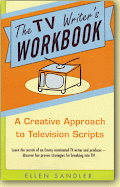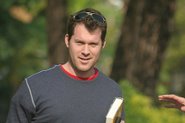



 Welcome to “Up Close and Personal.” For every interview I will be introducing a literary personality discussing his views and insights, as well as upcoming literary events around the world.
Welcome to “Up Close and Personal.” For every interview I will be introducing a literary personality discussing his views and insights, as well as upcoming literary events around the world.Today’s interview is with Larry Gonick. He is a cartoonist, best known for his book The Cartoon History of the Universe, a history of the world in a comic book form, which he has been publishing in installments since 1977.Mr. Gonick has also written The Cartoon History of the United States, and he has adapted the format for a series of co-written guidebooks on other subjects, beginning with The Cartoon Guide to Genetics in 1983. The diversity of his interests, and the success with which his books have met, have together earned him the distinction of being "the most well-known and respected of cartoonists who have applied their craft to unravelling the mysteries of science" Drug Discovery Today, March 2005.
Since 1990 to 1997, Mr Gonick penned a bimonthly Science Classics cartoon for the science magazine Discover. Each two-page comic discussed a recent scientific development, often one in interdisciplinary research.
He was a Knight Science Journalism Fellow at MIT in 1994 through 1995. In 1997, his 14-issue series, Candide in China, published on the WEB, described Chinese inventions.
Larry Gonick also writes the Kokopelli and; Company comic that appears in the magazine Muse and the satirical, anti-corporate comic “Commoners”.
E.I. Would you share some early insight into who you were as a teenager? What were you like? Please tell us more about Larry Gonick-- the man behind the award-winning writer and now a comic author?
LG: I grew up in Phoenix, where there was a lot of space to play outdoors. As little kids, we lived near huge vacant lots that were great places to make forts, run around, and step on these huge thorny burrs we called bullheads. Our feet got very tough in summer. My grade school, Grandview, had a 440-yard track, a couple of baseball diamonds, and many outdoor basketball courts. I was outdoors a fair amount. But I was basically a bookish kid, and rather shy. Not into tinkering or hardware. More on the theoretical side, though I can fix a faucet if I have to. Good student. Somewhat alienated, though I didn't feel this so acutely until high school. It came as a great relief when I finally met a few other outsider-intellectuals, who became proto-hippies soon thereafter.
Growing up, I had no specific goal for adulthood. Part of the reason was that I knew very few adults who weren't teachers (as my parents both were), so there was a lack of role models. I used to say I'd be either a writer or a mathematician—I was pretty good at both—but really had little idea what that would look like in real life. In college, I kind of backed into majoring in math, because I could get A's in it, and there wasn't much support for creative writing at Harvard in those days. Four years flew by, and I suddenly found myself applying for graduate school in math, which in those days pretty much meant going on to an academic career, without ever having consciously chosen that life path.
But I always liked to draw, too, and after college I picked it up again. One thing led to another, and in 1972 I dropped out of math and into cartooning.
E.I. What is it about the art form of writing cartoon text books that enchants you the most?
LG: What one thing? One? Thing? Um... it's a thing with several ingredients. Let's put it this way: the medium's ability to combine text and images into a narrative rhythm that delivers humor, opinion, and information all at once—in a way that's hard to forget!
E.I. What do you find to be the hardest part of writing it? Do you have sheets of newsprint covered in a story board all over your walls?
LG: No, the walls aren't covered. I do a page breakdown of each "volume" (a 48-page unit) on a single sheet of 9 x 12 sketchbook. And that's one of the easier parts. The hardest thing by far is writing the first draft. It's always too long by a factor of 3, and I'm conscious of that fact as I write. This generates an uncomfortable running internal argument with myself about nearly every sentence. I put down a few words and then think "but...", and then agonize about it a while, and then coach myself to follow through with that sentence and worry about editing it later, after it's written, etc. Just exhausting! Everything else is more or less fun.
E.I. What was your biggest challenge in writing “Cartoon History of the World”? How did you decide what level of details your reader will accept? Did you work them out in advance, or did they evolve as you wrote the story? How did you overcome these challenges?
LG: The level of detail is pretty much determined by one consideration: does the story make sense? I aim to put in everything necessary to make the story coherent, and very little else. In retrospect, I think I could have left more out of Modern World, Part
2. There's always a tradeoff between details and the big picture, and when you see the big picture, often really good jokes pop up. So, if I had to do it again, I think I'd put in more humor and less about, say, Kaiser Wilhelm II.
In a work of this complexity, pretty much the entire narrative framework is developed ahead of time. I used to wing it more, but now I'm convinced it pays to get organized.
E.I. How do you know where you will go next with your story? All the fascinating historical events and topics that have managed to slip through the gaps of common knowledge?
LG: In some sense, the main impulse for doing cartoon histories was to highlight the stuff that slipped through the gaps, as you put it. I'm a revisionist historian, or was when I started. Part of the point is to satirize received historical wisdom and the historians who promote it, especially when that received wisdom contains tendentious distortions, in other words, not to put to fine a point on it, the received wisdom serves the interest of the ruling class. And believe me, it isn't hard to find neglected and important information. When I started out, decades ago, there was a gold mine of data about women, minorities, and the underclass that had barely entered mainstream historical discourse. Later on, of course, this became mainstream historical discourse, at which point a lot of important narrative history dropped out of books, so paradoxically, by the end I was trying to restore some of the national-history type material that seemed absurdly traditional when I started out!
For example, I was horrified to discover not long ago that an 8th-grade history class had never heard of Magellan. I mean, really!
It also soon became clear to me that a lot of European history made much better sense in the context of Eurasian history, and this pointed me in the direction of Constantinople, first as a Byzantine capital and then under the Turks, not to mention China and India, which were the real centers of the world once upon a time. In the current book, this shows up in the very important role played in 18th-century European affairs by the decline of the Ottoman Empire.
Another example would be the British abolition of slavery in the early 1800s. I'm not aware of a parallel development anywhere, so it seemed to be a fruitful subject of study, and I spent many pages discussing it.
Another would be the birth of the Dutch Republic, which I covered in Modern World, Part 1.
E.I. If you were asked to read a page from “Cartoon History of the Modern World” is there one that you would personally select to share with your fans? And why?
LG: I just flipped through the book, and I really couldn't pick out just one. I like 202-203 for graphics. P. 39, introducing Napoleon, may be a good start. Not too complicated, and summarizes his exalted opinion of himself.
E.I. You are the most well-known and respected cartoonists in the writing community who have applied your craft to unraveling the mysteries of science, you were a Knight Science Journalism Fellow at MIT and now an award-winning writer. Do you ever feel pressure or insecure, or are you able to separate all that from your own creative process?
LG: I always feel pressure and insecurity, but it has nothing to do with upholding a reputation. It's more about all the inadequacies I see in my own work. I'm a perfectionist without the time or ability to perfect things.
E.I. What would you tell those authors considering applying to an M.F.A. program? In your opinion how important is it for a writer to have a writing degree?
LG: This is one I have no opinion about. It does seem to be important to have a writing degree if you want a day job teaching creative writing. But whether or not writing programs produce a certain kind of writing is a question I'm not qualified to answer.
E.I. Mr. Gonick, Thank you for contributing to my blog. It has been a pleasure for me to get to know your work a little better. Would you like to end your interview with a writing tip or advice for young aspiring writers?
LG: Edit yourself mercilessly, but not while you're in the middle of writing.
The Cartoon History of the Modern World, Part 2
Raw Materials
To learn more about Larry Gonick, please visit his website
To Purchase his books, please visit AMAZON and Barnes & Noble











.png)

















2 comments:
Hey, this was a quick, really warm and informative interview with a writer/cartoonist I've always admired and enjoyed reading again and again.
It's got some solid ideas about how history "changes" based on the POV of the time, and the informational flow of ideas and power. Perhaps the web and literally thousands of sites like yours will help "exploratory" minds find more that's not biased or controlled by situation (college courses)
Recently, from the ubuweb McLuhan page, I listened to McLuhan on the Dick Cavett show - or just listen to it here
http://www.youtube.com/watch?v=LcqB2TESg8g
The beauty of educators such as McLuhan and Gonick is that they have stong individual styles, while bring large and disperate ideas or studys to the rest of us in unconventional ways. Sweet!
As an artist and designer, I could have used a little shoptalk on style, why Gonick's art looks like it does, possible MAD magazine influence, etc. But you got deeper into the writing aspect, and that's great too.
Thanks for your efforts, and glad I found this!
Dennis Hermanson
Hillsborugh, NC USA
Hey, this was a quick, really warm and informative interview with a writer/cartoonist I've always admired and enjoyed reading again and again.
It's got some solid ideas about how history "changes" based on the POV of the time, and the informational flow of ideas and power. Perhaps the web and literally thousands of sites like yours will help "exploratory" minds find more that's not biased or controlled by situation (college courses)
Recently, from the ubuweb McLuhan page, I listened to McLuhan on the Dick Cavett show - or just listen to it here
http://www.youtube.com/watch?v=LcqB2TESg8g
The beauty of educators such as McLuhan and Gonick is that they have stong individual styles, while bring large and disperate ideas or studys to the rest of us in unconventional ways. Sweet!
As an artist and designer, I could have used a little shoptalk on style, why Gonick's art looks like it does, possible MAD magazine influence, etc. But you got deeper into the writing aspect, and that's great too.
Thanks for your efforts, and glad I found this!
Dennis Hermanson
Hillsborugh, NC USA
Post a Comment